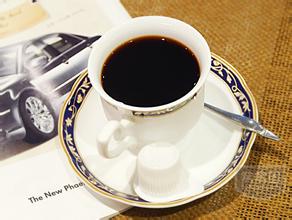The History of Colombian Coffee the icon connotation of Colombian coffee
Many people like to drink Colombian coffee, she has a silky taste, of all the coffee, it is the best balanced, soft, smooth and ready to drink. In terms of appearance and quality, the Columbia Super Class is quite excellent, just like a woman's vaguely charming, charming and just right, memorable. When it comes to Colombian coffee, I have to mention the logo of Colombian coffee. Whether you like Colombia or not, you must be no stranger to this logo. Do you know what parts it consists of and what it means?

The logo consists of three parts. The first part is the triangle of the background, which symbolizes the Andes and implies that most of the Arabica coffee growing areas in Colombian coffee belong to high-altitude mountains. It is well known that the main coffee producing areas in Colombia are located in three mountains arranged with the word "Sichuan", all of which are part of the Andes. According to the geographical environment and climate, the characteristics and flavor of coffee in different regions are the same. The second part is the mule. Please note that it is not a donkey! In Colombia coffee farmers actually use mules to carry coffee from the mountains. Because the mountain road in the coffee growing area of Colombia is very rugged, coffee farmers mostly use mules as a means of transportation. because of such unique geographical conditions, even with the development of transportation and science and technology today, it is impossible to transport coffee and raw beans from more than 1000 meters above sea level. and rugged mountain roads to transport coffee beans, so the way of carrying mules continues to this day. The third part is the man in the straw hat, who has a name. His name is Juan Valdez. People used to call him "Uncle JUAN VALDEZ". Juan Valdez is the representative image of Colombian coffee growers and a symbol of Colombian coffee, which distinguishes it from coffee from other countries of origin and is accepted by different markets. In the last 40 years, Colombian coffee growers have made great efforts to create the "JUAN VALDEZ" brand we see today. In 2005, the New York Times confirmed the importance of this brand in the United States, because its trademark recognition has exceeded many of the world's leading brands and gradually become a world-famous brand.

In order to better promote Colombian coffee, the Colombian Coffee Growers Association (FNC) launched a live-action version of Juan Valdez based on this image. Now the uncle is the third-generation real-life version. Uncle Juan Valdez, who represents Colombian coffee farmers, as the ambassador of Colombian coffee, will travel around the world to promote Colombian coffee. A beard, a straw hat and the mules around him are his necessary wardrobe. Uncle Dou was also happy to see him at the 2010 Shanghai World Expo.

The world coffee is divided into two series, one is the "hard" coffee represented by Brazil, which has a strong flavor, and the other is the "soft" coffee represented by Colombia, which has a light flavor. The difference lies in the altitude of the producing area and the method of planting. Coffee is planted extensively in hilly red soil in Brazil and intensive cultivation in mountain black soil in Colombia. Colombian coffee is divided into more than 200 grades, which means that the coffee is very regional. The country's coffee-producing areas are located in the Andes, where the climate is mild and the air is humid. Colombia has three Codiera mountains running north and south, right into the Andes. Coffee is grown along the highlands of these mountains. The mountain steps provide a diverse climate, where the whole year is the harvest season, and different kinds of coffee ripen at different times. And fortunately, unlike Brazil, Colombia doesn't have to worry about frost. There are about 700 million coffee trees in Colombia, 66% of which are planted in modern plantations and the rest on small traditionally run farms.

Important Notice :
前街咖啡 FrontStreet Coffee has moved to new addredd:
FrontStreet Coffee Address: 315,Donghua East Road,GuangZhou
Tel:020 38364473
- Prev

Boutique coffee Kenyan coffee latest news latest coffee introduction details
Kenya, located in East Africa, is one of the major coffee producing countries. More than 6 million people in the country are engaged in the coffee industry, mostly in the form of a combination of small farmers and cooperatives. Coffee trees in Kenya are mostly planted at 1400 m-2000 m above sea level, and the growing areas include Ruiri, Thika, Kirinyaga and Mt. Kenya West, Nyeri, Kiambu and Muranga. With Mt.Kenya
- Next

Hawaiian Kona coffee boutique coffee bean environment created boutique coffee
The world-famous Hawaiian Kona is a mellow and sour coffee bean, and its unique growth and climate make Hawaii Kona perfect: the smell of Hawaiian beaches, monsoon and volcanoes. Kona coffee beans produced in Hawaii are the most beautiful coffee beans in the world. They are extremely full and shiny. Kona coffee beans are evenly shaped and have a strong sour and sweet taste.
Related
- Detailed explanation of Jadeite planting Land in Panamanian Jadeite Manor introduction to the grading system of Jadeite competitive bidding, Red bid, Green bid and Rose Summer
- Story of Coffee planting in Brenka region of Costa Rica Stonehenge Manor anaerobic heavy honey treatment of flavor mouth
- What's on the barrel of Blue Mountain Coffee beans?
- Can American coffee also pull flowers? How to use hot American style to pull out a good-looking pattern?
- Can you make a cold extract with coffee beans? What is the right proportion for cold-extracted coffee formula?
- Indonesian PWN Gold Mandrine Coffee Origin Features Flavor How to Chong? Mandolin coffee is American.
- A brief introduction to the flavor characteristics of Brazilian yellow bourbon coffee beans
- What is the effect of different water quality on the flavor of cold-extracted coffee? What kind of water is best for brewing coffee?
- Why do you think of Rose Summer whenever you mention Panamanian coffee?
- Introduction to the characteristics of authentic blue mountain coffee bean producing areas? What is the CIB Coffee Authority in Jamaica?

